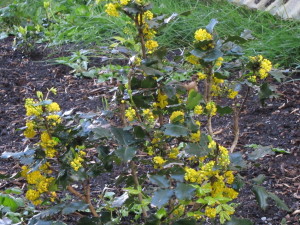
Welcome AtoZ Challenge bloggers! Keep on keeping on. We’re getting there!
***
Part of the fun of living in a woodsy area is learning about edible plants and how to forage for them. I’ve gone mushroom hunting, I can grab the first tender spring leaves of stinging nettle, and in late summer I pop blackberries, thimbleberries, and salal into my mouth straight from the wild plants so abundant here.
On one of my first such expeditions, armed with a pamphlet to guide me (don’t worry, I only fetch mushrooms with a guide), I discovered the Oregon grape. It’s not a grape, but its purple berries look like grapes, hence the name. Oregon grape grows wild here, and I planted one in my yard a few years ago that seems to be pretty happy. It’s a pretty little plant, perfect for the “food forest” concept I’m hoping to create in my front yard.
I’m a bit of a romantic when it comes to the great outdoors. Each plant I learn about, each adventure I take, brings me back to the childlike wonder that often gets buried in the stress of daily life. I take great delight in learning about unfamiliar foods that grow in the wild, even taking the time to learn more about the weeds that are edible. It’s fun to try new things, and I’m always sure I’m going to looooovvvvveeeee them.
Yes, I live my whole life this way. I see something that looks like fun to do and dive in headfirst.
I pop an Oregon grape into my mouth. And it is awful.
Bitter, bitter, bitter. Edible, yes, poisonous, no, but gross. Disgusting. If I were starving to death and Oregon grape was the only food available, I might just pass.
This happens in the rest of my life, too. My enthusiasm wanes when I realize that a) the new activities aren’t nearly as much fun as I thought they would be, b) the learning curve requires more time than what I’m willing to invest, or c) there just aren’t enough hours in a day. Reason (c) is why I’m about to sell my spinning wheel, but that’s another story for another time.
Turns out the locals mix Oregon grape with sweeter fruits (and often copious amounts of sugar) to make jelly. So then the question is, is the nutrition of an Oregon grape worth the unhealthy ingredients needed to make it palatable?
The leaves are sour, too, though they’re good in the springtime in a tea as a little tonic for the liver. The plant, especially the root, has antimicrobial properties and could be useful in treating infections.
But I suspect I’ll just keep the Oregon grape in my yard for its aesthetic value and leave the berries alone.
Yes, the Oregon Grape is a distinctive plant, but I can’t believe you actually ate one of its’ berries. You are incredibly brave. You definitely are educating me about plants too. Thanks.
Brave or foolish, I don’t know! 🙂 Curiosity killed the cat, so they say.
I feel really bad that I have not found my way here before! Today was the first time your comment had a link and I arrived via Twitter. Anyway, here I am and thanks for all your support at Anabel’s Travel Blog.
Thanks for stopping by! You have a wonderful blog.
Edible is not always a compliment 🙂
Succinct and true!
I think the Oregon Grape would be fine mixed with other berries. At least you are brave enough to go out and try. Not everyone does that.
~Patricia Lynne aka Patricia Josephine~
Member of C. Lee’s Muffin Commando Squad
Story Dam
Patricia Lynne, Indie Author
Some people mix them with blueberries, but even the thought of that makes my mouth pucker!
I think I’d be happy to try berries but wild mushrooms, maybe not. Just in case they weren’t edible.
Mushrooms make me nervous, too. I still wouldn’t trust myself alone with them.
LOL Well, who knew. It could have been your new favorite food. Nothing ventured, nothing gained.
Visit me at: Life & Faith in Caneyhead
I am Ensign B of Tremps’ Troops
with the A to Z Challenge
You’re right about that! I’m just always so sure I’ll think it’s great.
I’ve never heard of an Oregon grape.
Yes, it’s fun to try new things… keeps life fresh and exciting… you’ll never be bored. 🙂
Boredom is definitely not part of my life (thankfully)!